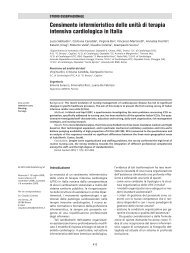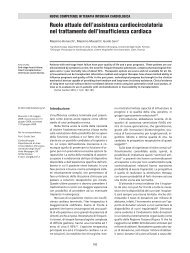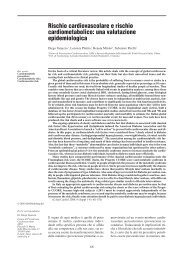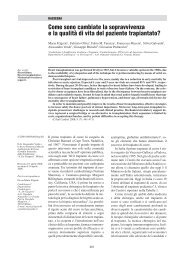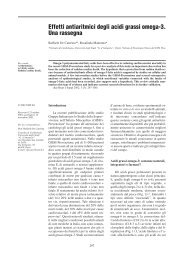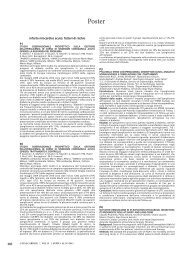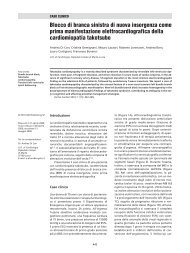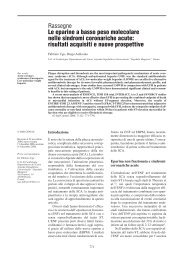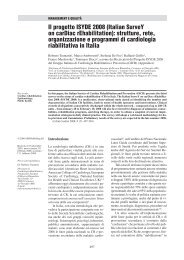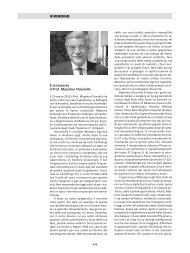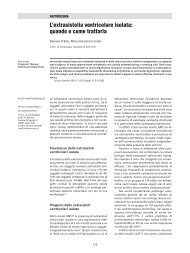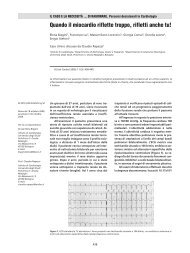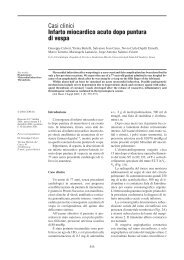COMUNICAZIONI - Giornale Italiano di Cardiologia
COMUNICAZIONI - Giornale Italiano di Cardiologia
COMUNICAZIONI - Giornale Italiano di Cardiologia
You also want an ePaper? Increase the reach of your titles
YUMPU automatically turns print PDFs into web optimized ePapers that Google loves.
G Ital Car<strong>di</strong>ol Vol 8 Suppl 2-5 2007<br />
Car<strong>di</strong>ologia interventistica coronarica<br />
C50<br />
DES VS BY-PASS NEL TRATTAMENTO DEL TRONCO COMUNE NON PROTETTO<br />
M. Ruffini, A. Santarelli, N. Franco, D. Santoro, R. Sabattini, Pesaresi, G. Belletti.<br />
G. Piovaccari<br />
Dipartimento Malattie Car<strong>di</strong>ovascolari, Rimini<br />
La malattia del Tronco Comune Non Protetto (TCNP) ha come in<strong>di</strong>cazione<br />
terapeutica elettiva la rivascolarizzazione con by-pass (BP), come suggerito dalle<br />
linee guida internazionali che definiscono invece l’angioplastica coronarica (PTCA)<br />
una possibile alternativa nei pazienti (pz) ad alto rischio chirurgico (EuroSCORE<br />
>10).In questi casi l’utilizzo <strong>di</strong> uno stent a rilascio <strong>di</strong> farmaco (DES) risulta promettente<br />
rispetto allo stent convenzionale (BMS). Nel nostro centro l’in<strong>di</strong>cazione ad un<br />
trattamento con PTCA del TCNP viene formulata in presenza <strong>di</strong> severa instabilità<br />
clinica e/o <strong>di</strong> severa comorbi<strong>di</strong>tà (EuroSCORE >6 = mortalità 30 giorni 11%).<br />
Scopo <strong>di</strong> questo stu<strong>di</strong>o è stato confrontare le caratteristiche cliniche e<br />
l’outcome a breve e me<strong>di</strong>o termine dei pazienti con malattia del TCNP avviati a<br />
rivascolarizzazione con BP o trattati con PTCA ed impianto <strong>di</strong> DES nel periodo<br />
Novembre 2003 - Marzo 2006. A tal fine abbiamo analizzato retrospettivamente i<br />
dati clinici ed angiografici <strong>di</strong> queste due popolazioni ed effettuato un follow-up<br />
aggiornato al Dicembre 2006.<br />
Risultati. Nel periodo <strong>di</strong> osservazione sono stati sottoposti a rivascolarizzazione<br />
134 pz con malattia del TCNP. 58 pz sono stati avviati al BP (gruppo 1) mentre 76 pz<br />
sono stati trattati con PTCA: 51 con impianto <strong>di</strong> DES (gruppo 2) e 25 con impianto<br />
<strong>di</strong> BMS. Dall’analisi delle caratteristiche cliniche emerge che i pazienti del gruppo 2<br />
erano significativamente più anziani (74±9 vs 67±8, p3X ULN); there were<br />
no death, no Q-wave MI (NQWMI). At 30 days of follow-up, one patient (2%) had<br />
a sub-acute stent thrombosis with a NQWMI related to double anti-platelet<br />
therapy early cessation.<br />
Clinical (3-6-9-12 and end study stress test evaluation and car<strong>di</strong>ological<br />
consultation) follow-up (23.0 ± 7.3 months; range 13-40) was obtained in all<br />
patients. MACE rate was 14%: three target lesion revascularisation (TLR, 6%)<br />
and four death (total mortality 8%, 6% car<strong>di</strong>ac**, 2% non car<strong>di</strong>ac). The ischemia<br />
driven angiographic follow-up was performed in 56% of patients between 6 and<br />
12 months after the index procedure and showed three (6%) clinical restenosis,<br />
all treated successfully by PCI (4%) or CABG (2%).<br />
All follow-up MACE occurred within the seven months after the index procedure<br />
except the only non car<strong>di</strong>ac death that occurred during the second year from the<br />
procedure.<br />
80% of follow-up MACE occurred in <strong>di</strong>stal ULMCA stenosis.<br />
Conclusion. PCI with SES for ULMCA is safe with an acceptable mid-term<br />
outcome. However, <strong>di</strong>stal left main stenosis remains a therapeutic challenge with<br />
a higher risk of restenosis and car<strong>di</strong>ac death. CABG remains the gold standard<br />
treatment for this specific anatomic setting.<br />
*stenting of <strong>di</strong>stal ULMCA, ostial and proximal LAD.<br />
**car<strong>di</strong>ac death if absence of sure extra car<strong>di</strong>ac causes.<br />
C52<br />
PROLONGED DUAL ANTIPLATELET THERAPY FOLLOWING DRUG-<br />
ELUTING STENT IMPLANTATION AND RISK OF BLEEDING EVENTS<br />
N. Morici*, F. Airol<strong>di</strong>°, N. Brambilla*, A. Latib°, A. Chieffo°, G. Melzi°, S. Lanotte*,<br />
J. Cosgrave°, F. Bedogni*, A. Colombo°<br />
*Interventional Car<strong>di</strong>ology Department, Sant’Ambrogio Clinical Institute, Milan,<br />
Italy; °Invasive Car<strong>di</strong>ology Unit, San Raffaele Scientific Institute and EMO<br />
Centro Cuore Columbus, Milan, Italy<br />
Following percutaneous coronary intervention (PCI) and drug-eluting stent (DES)<br />
implantation, clopidogrel therapy in ad<strong>di</strong>tion to aspirin has led to greater protection<br />
from thrombotic complications than aspirin alone. However, the optimal duration of<br />
combined antithrombotic therapy is unknown. On the basis of observational stu<strong>di</strong>es,<br />
thienopyri<strong>di</strong>ne should be given for at least six months, and ideally up to 12 months in<br />
patients who are not at high risk for blee<strong>di</strong>ng. However, assessment of blee<strong>di</strong>ng<br />
events associated with long-term therapy has not been considered.<br />
We have analysed 1724 consecutive patients treated with DES between April<br />
2002 and December 2004. Combination treatment with aspirin and thienopyri<strong>di</strong>ne<br />
was assigned for at least three months after sirolimus-eluting stent implantation<br />
and for six months after paclitaxel-eluting stent implantation. At 18-month followup<br />
overall rate of antiplatelet therapy associated adverse events was 3.0 %<br />
(53/1724), with 1.1% (19/1724) of serious adverse events and 1.97% (34/1724)<br />
of minor side effects.<br />
Among serious adverse events, all of them requiring hospitalisation, we recorded<br />
4 cases of intracranial haemorrhage, observed respectively after 75, 180, 263,<br />
and 463 days from DES implantation; one of them after blunt head trauma. In all<br />
these cases a cerebral event was the reason for subsequent antiplatelet therapy<br />
<strong>di</strong>scontinuation. Other major events were thrombocytopaenia (1 pt), urogenital<br />
blee<strong>di</strong>ng (1 pt), retinal haemorrhage (1 pt), cholestatic hepatitis (1 pt), and severe<br />
anaemia requiring blood transfusions (11 pts). Minor events included all cases of<br />
mild-moderate gastrointestinal blee<strong>di</strong>ng and drug allergy.<br />
Antithrombotic treatment is increasingly becoming aggressively prescribed. Even<br />
if effective in preventing stent thrombosis and atherosclerotic <strong>di</strong>sease associated<br />
atherothrombosis, antiplatelet therapy can increase the blee<strong>di</strong>ng risk. The<br />
decision to treat a patient with an aggressive antithrombotic regimen for an<br />
extended time period needs to take into account these associated complications.<br />
C53<br />
EVALUATION OF DRUG-ELUTING-STENT BY 64-SLICE MULTI-DETECTOR<br />
COMPUTED TOMOGRAPHY<br />
N. Carrabba, M. Bamoshmoosh*, L.M. Carusi*, G. Paro<strong>di</strong>, R. Valenti,<br />
A. Migliorini, F. Fanfani*, D. Antoniucci<br />
Division of Car<strong>di</strong>ology, Careggi Hospital, Florence, Italy, *Fanfani Clinical<br />
Research Institute, Florence, Italy<br />
Objectives. Noninvasive imaging of in-stent restenosis (ISR) would be clinically<br />
useful, but artifacts caused by metallic stent struts have limited the role of early<br />
generation multi-detector computed tomography (MDCT) scanners. The aim of this<br />
study was to assess the accuracy of a new generation spiral MDCT scanner (Brilliance<br />
64, Philips Me<strong>di</strong>cal Systems, Cleveland, Ohio) in the <strong>di</strong>agnosis of coronary ISR.<br />
Methods. We examined 41 asymptomatic patients (age 68±8.7 years, 4 women)<br />
with 87 implanted coronary stents (70 drug-eluting stents) who were referred for<br />
repeat 6-month invasive coronary angiography (ICA). Patients underwent MDCT<br />
6.7±6.9 days before scheduled ICA, using intravenous contrast enhancement.<br />
Images were reconstructed in multiple formats using retrospective<br />
electrocar<strong>di</strong>ographic gating. Stents were viewed in their long and short axes, and<br />
were visually classified for the presence or absence of binary ISR (<strong>di</strong>ameter<br />
reduction >50%), inclu<strong>di</strong>ng the 5-mm borders proximal and <strong>di</strong>stal to the stent.<br />
Results. ISR was found by ICA in 13 (15%) of the stented segments and in 8<br />
(19%) patients. Among these, 11 ISR were correctly detected by MDCT;<br />
ad<strong>di</strong>tionally one severely calcified stented segment was considered as occluded<br />
by MDCT (sensitivity 84%, 95% CI 54-98%). Seventy-three of 74 stentedsegment<br />
without ISR were correctly classified by MDCT (specificity 97%, 95% CI<br />
93-100%), whereas two stented-segments were classified as false negative ISR.<br />
Positive pre<strong>di</strong>ctive value (PPV) was 92% (95% CI 84-97%), negative pre<strong>di</strong>ctive<br />
value (NPV) was 97% (95% CI 90-99%), and pre<strong>di</strong>ctive accuracy was 96% (95%<br />
CI 90-99%). After the exclusion of the calcified stented-segment, the sensibility,<br />
the specificity, the PPV, the NPV and the pre<strong>di</strong>ctive accuracy were 84% (95% CI<br />
74-91%), 100% (95% CI 96-100%), 100% (95% CI 96-100%), 97% (CI 90-99%)<br />
and 98% (95% CI 92-99%) respectively.<br />
Conclusions. The high NPV makes MDCT a potentially valuable <strong>di</strong>agnostic tool<br />
in patients with low expected ISR. However, whether MDCT will be a clinically<br />
useful and cost-effective tool for the evaluation of ISR remains to demonstrate in<br />
clinical arena.<br />
C54<br />
INSUFFICIENZA RENALE CRONICA, PCI MULTIVASALE: TRATTAMENTO E<br />
PREVENZIONE<br />
C. Budano, M. Di Tria, M. Levis, M. D’Amico, T. Usmiani, A. Mazzanti,<br />
G. Lanfranco*, C. Guarena*, S. Marra<br />
S.C.Car<strong>di</strong>ologia Ospedaliera 2 A.O.S., S. Giovanni Battista-Molinette, Torino,<br />
*S.C.U. Nefrologia, Dialisi e Trapianto Renale, S. Giovanni Battista-Molinette,<br />
Torino<br />
Premessa. La nefrotossicità da mezzo <strong>di</strong> contrasto (CIN, contrast-induced<br />
nephropathy) è definita come un deterioramento della funzione renale<br />
caratterizzato da un aumento della creatinina <strong>di</strong> più del 25% entro 3 giorni dalla<br />
somministrazione <strong>di</strong> mezzo <strong>di</strong> contrasto (mdc). La CIN è <strong>di</strong> solito temporanea e<br />
la creatinina ritorna al valore basale entro 15 giorni nel 75% dei casi. Nei<br />
car<strong>di</strong>opatici sottoposti a procedure interventistiche coronariche l’incidenza <strong>di</strong> CIN<br />
varia dal 3.3% al 14.5%. Scopo dello stu<strong>di</strong>o è stato quello <strong>di</strong> valutare l’incidenza<br />
<strong>di</strong> CIN in una popolazione <strong>di</strong> pz con elevato profilo <strong>di</strong> rischio car<strong>di</strong>ovascolare,<br />
26S



